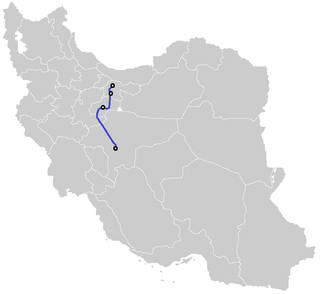Tehran–Qom–Isfahan High Speed Rail
Tehran–Qom–Isfahan High Speed Rail is the first truly high-speed rail project in Iran. Construction began on 25 February 2015.[3][1][4] The rail line would decrease travel times between Tehran and Isfahan, passing through Qom. It connects Isfahan and Qom to Imam Khomeini International Airport.[5]
| Tehran-Qom-Isfahan High Speed Rail | |||
|---|---|---|---|
| Overview | |||
| Native name | راه آهن تندرو تهران-قم-اصفهان | ||
| Type | High-speed rail | ||
| Status | Under construction | ||
| Locale | Tehran Province, Qom Province, Isfahan Province | ||
| Termini | Tehran Isfahan | ||
| Stations | 4 (Planned) | ||
| Operation | |||
| Owner | Islamic Republic of Iran Railways | ||
| Technical | |||
| Line length | 410 km (250 mi)[1] | ||
| Track gauge | 1,435 mm (4 ft 8 1⁄2 in) standard gauge | ||
| Electrification | Overhead catenary | ||
| Operating speed | 300 km/h[2] | ||
| |||
Tehran-Qom-Isfahan High Speed Rail | ||||||||||||||||||||||||||||||||||||||||||||||||||||||||
|---|---|---|---|---|---|---|---|---|---|---|---|---|---|---|---|---|---|---|---|---|---|---|---|---|---|---|---|---|---|---|---|---|---|---|---|---|---|---|---|---|---|---|---|---|---|---|---|---|---|---|---|---|---|---|---|---|
| ||||||||||||||||||||||||||||||||||||||||||||||||||||||||
The project is implemented by a Chinese consortium led by the China Railway Engineering Corporation.[1] Completion is planned in 2021.[3]
Concept
This line was the first high-speed railway proposed after the Islamic Revolution about 1990. The available technology allowed speeds of 270 km/h as in TGV in France and ICE in Germany.
After accepting the proposal for electrification of Tehran–Mashhad railway and increasing the target speed to 200 for locomotive-hauled trains and 250 for EMU, Tehran-Esfahan high-speed was studied for increasing the speed in 2006.
The available technology and standard at that time was suitable to go to 350 km/h. This was proposed to the road and transportation minister. The subject was referred to a consultant, and the geometry of track was studied again and was found acceptable for 350 for 70% of the Qom to Esfahan.
Stations
- Tehran railway station
- Imam Khomeini International Airport Terminal 2 and 3 Railway Station (planned)
- Qom New railway station (planned)- Intersection with Arak–Qom High Speed Rail[6][7]
- Isfahan-North railway station (planned)
References
- UK, DVV Media. "Tehran – Esfahan line should be TSI-compliant, RAI tells Chinese contractors". Railway Gazette.
- -سرعت قطار تندرو تهران-اصفهان 300 کیلومتر
- "Tehran-Isfahan High Speed Rail (Construction)". reconnectingasia.csis.org. Retrieved 5 March 2020.
- "China Finances Tehran-Isfahan High-Speed Railroad". Financial Tribune. 21 July 2017.
- "زمان سفر از اصفهان به تهران با قطار سریع السیر دو ساعت می شود" [Travel time from Tehran to Isfahan acceleratlocomotive-hauleddate=3 December 2014]. RTCGuild.com.
- https://plus.google.com/113403756129291503583 (3 July 2017). "Iran, Italy to Sign €1.2b Railroad Deal". Financial Tribune. Retrieved 30 May 2020.
- scoding607. "Preliminary design of Qom-Arak High Speed Railway Line". Coding. Retrieved 30 May 2020.
